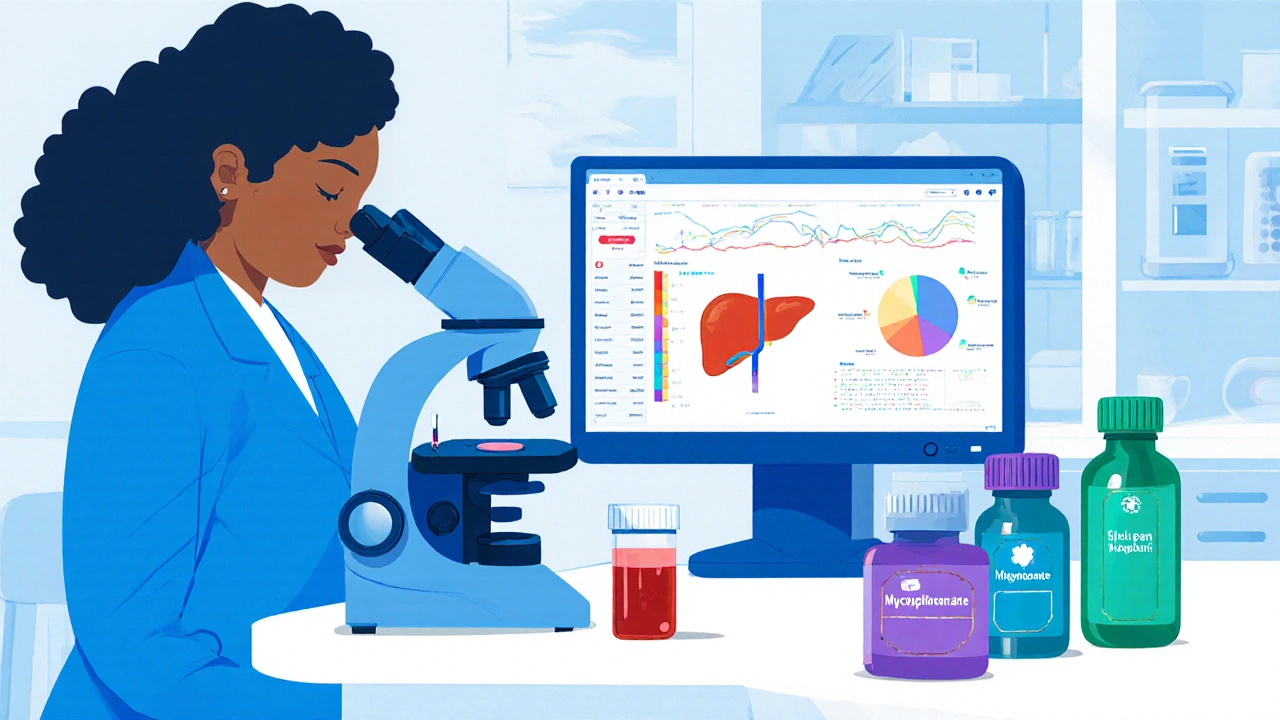
Immunosuppressant Drug Comparison Tool
Select a condition and your current medication to compare alternatives:
When doctors prescribe an immunosuppressant, they often start with Imuran (azathioprine) because it’s affordable and works for many autoimmune conditions. But no drug is perfect-some patients experience nausea, liver enzyme spikes, or need a stronger punch for organ‑transplant maintenance. That’s where Azathioprine alternatives come into play. This guide breaks down the most popular substitutes, shows where each shines, and helps you decide which option matches your health goals.
What is Imuran (Azathioprine) and How Does It Work?
Azathioprine is a pro‑drug that converts into 6‑mercaptopurine inside cells. The active metabolites inhibit DNA synthesis, dampening the proliferation of T and B lymphocytes. In plain terms, it slows down the immune system’s over‑reaction without wiping it out completely. Because of that balance, Imuran is a first‑line choice for rheumatoid arthritis, inflammatory bowel disease, systemic lupus, and as a maintenance drug after organ transplantation.
Key Factors to Compare When Choosing an Alternative
- Efficacy for the specific disease - Does the drug achieve remission rates comparable to azathioprine?
- Side‑effect profile - Which adverse events are most common, and how severe are they?
- Monitoring requirements - Frequency of blood work, liver function tests, or drug level checks.
- Cost and insurance coverage - Out‑of‑pocket expense can sway the decision.
- Dosing convenience - Daily oral pill versus twice‑daily or injectable forms.
Side‑by‑Side Comparison Table
| Drug | Typical Indications | Mechanism | Key Side Effects | Monitoring | Average Monthly Cost (US) |
|---|---|---|---|---|---|
| Imuran | Rheumatoid arthritis, IBD, lupus, transplant maintenance | Purine synthesis inhibition via 6‑mercaptopurine | Nausea, liver enzyme elevation, leukopenia | CBC & LFT every 2-4weeks initially, then quarterly | $10‑$30 |
| Mycophenolate mofetil | Kidney transplant, lupus nephritis, IBD | Inhibits inosine monophosphate dehydrogenase → blocks guanine synthesis | GI upset, leukopenia, increased infection risk | CBC every 1-2weeks, renal function quarterly | $150‑$250 |
| Methotrexate | Rheumatoid arthritis, psoriasis, certain cancers | Folate antagonist → reduces DNA replication | Liver toxicity, mouth ulcers, pulmonary fibrosis (rare) | LFT & CBC every 4-8weeks, folic acid supplementation | $20‑$60 |
| 6‑Mercaptopurine | IBD (especially ulcerative colitis) | Direct purine analog - similar to azathioprine but active form | Bone marrow suppression, liver toxicity | CBC & LFT every 2weeks, TPMT testing before start | $30‑$50 |
| Leflunomide | Rheumatoid arthritis, psoriatic arthritis | Inhibits dihydroorotate dehydrogenase → blocks pyrimidine synthesis | Hypertension, hepatotoxicity, teratogenicity | LFT every month, cholesterol check | $70‑$120 |
| Cyclosporine | Organ transplant, severe psoriasis, uveitis | Calcineurin inhibition → blocks IL‑2 transcription | Nephrotoxicity, hypertension, gum hyperplasia | Drug level (ng/mL) 2‑3times/week initially, renal function | $200‑$350 |
| Infliximab (Biologic) | Crohn’s disease, rheumatoid arthritis, ulcerative colitis | Anti‑TNFα monoclonal antibody | Infusion reactions, infection, reactivation of TB | Baseline TB screening, CBC annually, infusion monitoring | $1,200‑$1,800 per infusion (often covered by insurance) |

When Each Alternative Makes Sense
Mycophenolate mofetil shines in kidney transplant patients because it provides stronger suppression of T‑cell activation without the same hepatic toxicity seen with azathioprine. If liver enzymes are a red flag for you, Mycophenolate is a good pivot.
Methotrexate is the go‑to for rheumatoid arthritis when weekly dosing and folic acid rescue are acceptable. Its anti‑inflammatory effect often exceeds that of azathioprine, but you must keep an eye on liver enzymes and avoid alcohol.
6‑Mercaptopurine is essentially “azathioprine in a bottle.” It’s chosen when patients metabolize azathioprine poorly (e.g., TPMT deficiency). Starting doses are lower, and therapeutic drug monitoring is essential.
Leflunomide offers oral convenience for arthritis sufferers who can tolerate the blood‑pressure rise. However, women of childbearing age must avoid it because of severe birth defects.
Cyclosporine remains a staple for organ‑transplant protocols where rapid, potent suppression is needed. The trade‑off is kidney monitoring-if your creatinine creeps up, you’ll need dosage adjustments.
Infliximab and other biologics represent a different class altogether. They bypass the metabolic pathways that cause azathioprine’s blood‑count drops, but they bring infusion‑related risks and higher upfront costs.
Practical Tips for Switching from Imuran
- Baseline labs: Get CBC, liver function, renal function, and TPMT activity before you stop azathioprine.
- Taper, don’t quit cold turkey: Reduce the dose by 25% every 1‑2weeks while the new drug reaches steady state.
- Overlap period: For drugs like mycophenolate, maintain a low dose of azathioprine for 1week to avoid a flare.
- Watch for infection: Immunosuppressants lower defense; schedule a prophylactic flu shot and consider pneumococcal vaccination.
- Insurance pre‑auth: Many alternatives need prior authorization. Have your prescribing physician submit the indication and recent lab results.
Risks to Keep in Mind Across All Options
Regardless of the drug you end up on, the biggest threats are infection, malignancy risk, and organ‑specific toxicity. The good news is that regular monitoring catches most problems early. For example, a rise in creatinine while on cyclosporine often reverses when the dose drops, whereas a subtle drop in neutrophils on azathioprine can signal the need for a temporary hold.
Bottom Line: Choose the Right Tool for Your Body
There’s no one‑size‑fits‑all answer. If you struggle with liver issues, shift toward mycophenolate or a biologic. If cost is a concern and you tolerate azathioprine well, sticking with Imuran may still be the smartest move. Discuss the comparison table with your rheumatologist or transplant team-together you’ll weigh efficacy, side effects, and lifestyle factors to land on the best fit.

Frequently Asked Questions
Can I take azathioprine and mycophenolate together?
Combining two strong immunosuppressants dramatically raises infection risk and is usually reserved for very severe cases under close hospital supervision. Most clinicians prefer to switch rather than stack.
How long does it take for mycophenolate to work compared to azathioprine?
Mycophenolate reaches therapeutic levels within a week, but clinical remission in transplant patients often takes 4‑6weeks, similar to azathioprine. For rheumatoid arthritis, you may notice symptom relief in 2‑3months.
Is methotrexate safer for the liver than azathioprine?
Both drugs can affect liver enzymes, but methotrexate’s toxicity is dose‑dependent and mitigated with weekly folic acid. Regular liver panels keep both drugs safe when monitored.
Do biologics like infliximab require lab monitoring?
Biologics need baseline infection screening (TB, hepatitis) and periodic blood counts, but they don’t require daily drug‑level checks. Monitoring focuses on infection signs and infusion reactions.
What should I do if I develop a rash while on azathioprine?
Contact your prescriber right away. A rash can signal hypersensitivity or early liver involvement. The doctor may lower the dose or switch to another agent.
When you step into the battlefield of immunosuppression, you need a weapon forged in the crucible of both efficacy and economy, and Imuran stands as the flag‑bearing standard for that cause. Its mechanism-purine synthesis inhibition-cuts the rogue T‑cell army right at the source, delivering a surgical strike without the collateral damage of wholesale cytotoxicity. In the sprawling arena of rheumatoid arthritis and IBD, it delivers remission rates that rival the flashier biologics, all while keeping the patient’s wallet from screaming for mercy. The side‑effect profile, though not without its gremlins-nausea, liver enzyme spikes, and occasional leukopeneric dips-remains manageable under vigilant CBC and LFT surveillance. The cost, a modest $10‑$30 per month, is a rallying cry for patients sidelined by insurance red tape. Compared to Mycophenolate, which charges a premium of $150‑$250, Imuran’s frugality is a patriotic act of defiance against pharmaceutical greed. Moreover, the drug’s oral convenience-once‑daily dosing-means adherence is as simple as a morning coffee ritual, a small but significant morale booster in chronic disease management. Theoretically, one could argue that the drug’s modest potency makes it a stepping‑stone, but clinical experience tells us that many patients never need to climb higher. When liver enzymes do climb, a dose reduction or a brief drug holiday can tame the rebellion without abandoning the frontline entirely. The monitoring schedule-CBC and LFT every 2‑4 weeks initially, then quarterly-provides a rhythm that keeps physicians and patients in sync, much like a well‑timed march. For organ‑transplant recipients, Imuran offers a gentler approach than Cyclosporine’s nephrotoxic artillery, preserving renal function while maintaining graft tolerance. Its interaction profile is relatively clean, sparing patients the labyrinth of drug‑level draws that Cyclosporine demands three times a week. In the grand tapestry of immunosuppression, Imuran weaves a thread of accessibility, efficacy, and safety that few alternatives can match without demanding a heavier price in either side‑effects or dollars. If you’re battling the daily siege of autoimmune flares, consider Imuran not just as a drug, but as a strategic ally in the war for quality of life. The evidence, the economics, and the patient stories all converge on a singular truth: sometimes the simplest tool is the most effective, especially when wielded with disciplined monitoring and a steadfast commitment to health.
Imuran certainly offers a solid baseline, but it’s worth noting that the therapeutic landscape has expanded with options that can be tailored to individual tolerances and lifestyle preferences 😊. For patients who experience hepatic concerns, transitioning to Mycophenolate may provide a smoother liver profile while maintaining comparable immunosuppressive potency.
One must question the very ontology of “best” when discussing immunosuppressants; the notion is a construct that obscures the ethical imperative to prioritize patient autonomy above pharmaceutical dogma. Declaring Imuran the universal answer betrays a simplistic reductionism that neglects the nuanced interplay of genetics, comorbidities, and socioeconomic constraints. While its cost-effectiveness is indisputable, the moral calculus demands we also weigh the invisible toll of chronic leukopenia on a patient’s existential experience. Therefore, a prescriber who uncritically defaults to Imuran is, in effect, imposing a monolithic creed upon a pluralistic community of sufferers.
Oh, because what the world truly needed was another table of drug names and their “side‑effects,” right? The excitement of comparing cost brackets feels almost as riveting as watching paint dry on a hospital wall.
i think its cool how imuran cost is low but sometimes the nausea thing can be a real bummer the labs need to be done often its kinda annoying but hey its cheaper than most meds
Hey folks, if you’re feeling stuck on Imuran, don’t forget you have options! A little chat with your rheumatologist can open doors to Mycophenolate or even a biologic if you need that extra push. Keep the conversation going and stay proactive about your health journey!
Alright, let’s break this down step by step. First, you’ve got Imuran, a purine synthesis inhibitor, which is great for a broad range of autoimmune conditions because it’s cheap and generally well tolerated. Next up, Mycophenolate mofetil-this one works by blocking guanine synthesis, offering a stronger T‑cell suppression, which is why it’s a favorite in transplant protocols, but you’ll notice the price tag jumps significantly. Then there’s Methotrexate, a folate antagonist that’s been a workhorse in rheumatology for decades; it’s taken weekly and you’ll need to pair it with folic acid to keep those mouth ulcers at bay. Don’t overlook Leflunomide either; it targets pyrimidine synthesis and can be a solid second‑line for arthritis, though you’ll need to monitor blood pressure. Cyclosporine, on the other hand, is a calcineurin inhibitor-think of it as the heavy‑hitter for organ transplants, but the nephrotoxicity risk means you’ll be checking kidney labs more often. Finally, if you’re ready to jump into the biologic arena, Infliximab offers anti‑TNFα action, which can be a game‑changer for Crohn’s or RA, albeit with infusion‑related logistics and higher costs. Bottom line: the right drug depends on your specific disease, how your body reacts, and what your insurance will cover, so have a detailed sit‑down with your specialist and weigh the pros and cons of each option.
Esteemed colleagues, the comparative analysis delineated herein elucidates the pharmacodynamic and pharmacoeconomic variables intrinsic to each immunosuppressive agent. Imuran’s modest cost‑benefit ratio renders it a viable first‑line therapy, whereas agents such as Mycophenolate and Cyclosporine, whilst exhibiting superior potency, impose substantial fiscal and monitoring burdens. A judicious appraisal of patient‑specific factors-namely hepatic function, renal parameters, and disease phenotype-is indispensable to optimize therapeutic outcomes.
Imuran, indeed, offers a cost‑effective solution; however, one must also consider its side‑effect profile, especially hepatic enzyme elevation, and leukopenia! Moreover, Mycophenolate presents an alternative with a different mechanism, but its higher price may be prohibitive! In clinical practice, balancing efficacy, safety, and affordability is paramount!
Our great nation deserves drugs that are both affordable and effective, and Imuran embodies that principle! While foreign manufacturers push expensive biologics, we must support home‑grown, low‑cost options that keep our healthcare system strong!
The pharmaceutical industry, with its labyrinthine networks of lobbyists and shadowy boardrooms, has engineered the very perception that newer, pricier immunosuppressants are inherently superior, while deliberately obfuscating the robust data supporting a century‑old drug like Imuran. When you examine the funding trails, you’ll notice that the majority of clinical trials touting Mycophenolate or biologics are sponsored by corporations that stand to profit billions, whereas independent studies on azathioprine receive scant attention. This asymmetry is no accident; it’s a calculated maneuver to funnel patients toward high‑margin products, ensuring a continuous flow of revenue that fuels further research aimed at widening the therapeutic monopoly. The regulatory apparatus, complicit in this grand design, often fast‑tracks approvals for these lucrative agents while subjecting older generics to endless scrutiny. Meanwhile, the average patient is left grappling with soaring insurance premiums and out‑of‑pocket costs, all under the guise of “advanced care.” It’s a stark reminder that medical progress is not solely guided by scientific merit but is heavily influenced by economic incentives and power structures that operate behind the curtains of public health discourse.
Don’t be fooled by the hype around the newest drugs; the big pharma machine wants you scared enough to drop cash on their patented stuff. Stick with what works and cheap, like Imuran, and you’ll avoid the hidden traps they set.
Great, another spreadsheet of side effects-thrilling read.
While the tabular data can seem dense, it actually equips patients with the clarity needed to make informed choices about their treatment pathways.
Imuran’s pharmacokinetic profile is well‑characterized, with peak plasma concentrations occurring within two hours post‑administration and a half‑life conducive to once‑daily dosing, facilitating adherence.
Indeed, clear presentation of efficacy and safety metrics supports shared decision‑making, which is essential for optimal therapeutic outcomes.
The choice of immunosuppressant ultimately reflects a balance between biological necessity and personal circumstance, reminding us that medicine is both science and lived experience.